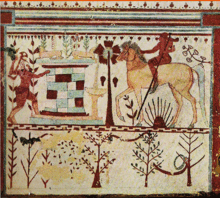Tomba dei Tori
The Tomba dei Tori (German: "Grave of the bulls") is a decorated Etruscan grave in Tarquinia in the Italian province of Viterbo . It is part of the Monterozzi Necropolis , which has been a UNESCO World Heritage Site since 2004 .
The grave dates from around 550/540 BC. It is a total of 15.70 meters long; the main chamber is 4.65 meters wide and 2.40 meters high. The side chamber measures 2.40 meters by 2.30 meters; it is 1.50 meters high. The grave was uncovered in 1892 and was considered the oldest painted grave in Tarquinia until 1968.
Paintings
It is the only grave whose painting deals with a Greek theme. The tomb paintings of Tarquinia show the close relationship with Greek art. Some graves are believed to have been designed by Greek artists. In carrying out their work, however, they must have been forced to adapt to the taste in color and the manners and customs of the Etruscan people. Therefore, despite the Greek influence, the subjects of the paintings are mostly not Greek. The tomb of the bulls is an exception.
Achilles representation
The scene depicted there relates to the story of the Greek hero Achilles from the Trojan sagas, here Achilles betraying Troilos , the son of Priam . This theme has often been depicted on Greek vases, and the representation in the tomb may have been influenced by such vase paintings. Achilles lurks to the left behind a well and is about to jump at the young Troilos, who comes ridden on a horse, unsuspecting. Great importance was attached to the reproduction of nature, albeit in largely abstract forms: in the center is a stylized palm tree, reeds and bluebells are distributed over the entire field of view and pomegranate blossoms form the upper frame.
The Tomba dei Tori is the only archaic tomb that certainly has a mythological scene as its content. Although the plot is based on a fixed iconographic principle, the two figures appear isolated and unrelated to each other - not in the unity of a dramatic plot. Obviously there is no “similarity in spirit” to the Greeks here, only stylistic copying. The Ionic model reveals itself most clearly in the long flowing hairstyle of Troilos.
Erotic representation
On the upper gable of this wall two “erotic groups” can be seen, which are associated with the bull myth. Above the left door a man and a woman are depicted having sexual intercourse, a second man kneels on a mat.
The skin of men is dark red-brown, that of women is painted very light, thus following Egyptian art. The women of the Etruscans were much more emancipated than those of the Greeks or Romans. For example, they were allowed to watch the men's competitions, which was forbidden in the Greek Olympia with the death penalty. In the tombs, women were often depicted as mistresses.
The scene above the right door is commonly referred to as homosexual ; the passive person is neither a man nor a woman according to the color scheme that was common in the entire ancient Mediterranean region. A bull runs towards the group from the left, clearly wearing a human face. It is Acheloos , in the legend a manifestation of Dionysus , the intoxicating antagonist of the classical Apollo .
literature
- Robert Hess, Elfriede Paschinger: Etruscan Italy. Discovery trips to the art sites and necropolis of the Etruscans. 5th edition. DuMont, Cologne 1985, ISBN 3-7701-0637-7 , p. 236.
- Ezio Renda: Tarquinia. German edition. Bonechi Edizioni "Il Turismo", Florence 1984, p. 36.
- Maja Sprenger , Gilda Bartoloni: The Etruscans. Art and history. Recordings by Max and Albert Hirmer. Hirmer, Munich 1977, ISBN 3-7774-2890-6 , p. 107.
- Stephan Steingräber : Etruria. Cities, sanctuaries, necropolises. Hirmer, Munich 1981, ISBN 3-7774-3330-6 , pp. 384-385.
Coordinates: 42 ° 14 '24 " N , 11 ° 47' 39.8" E

